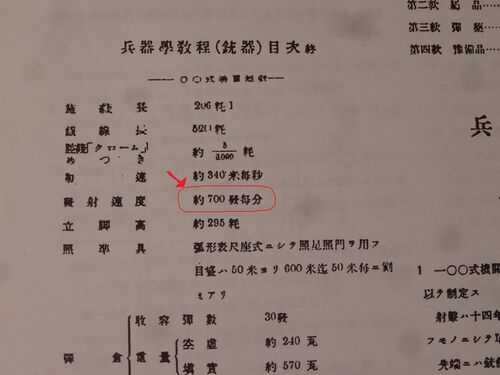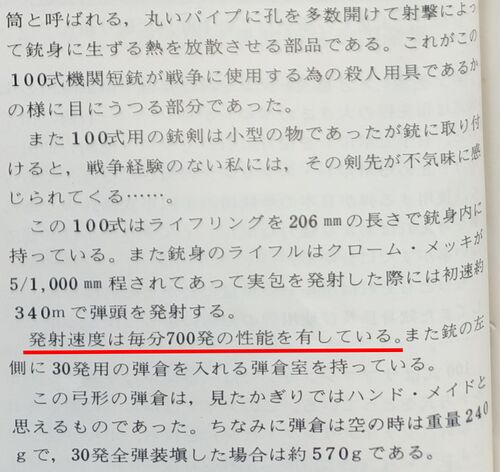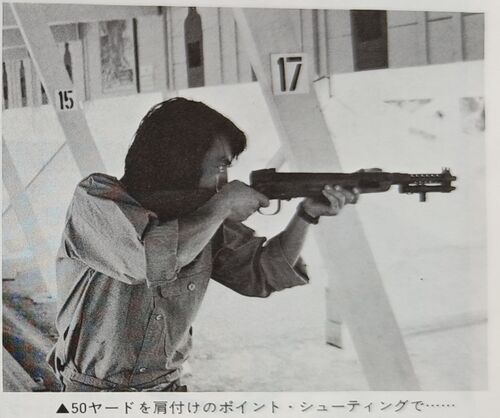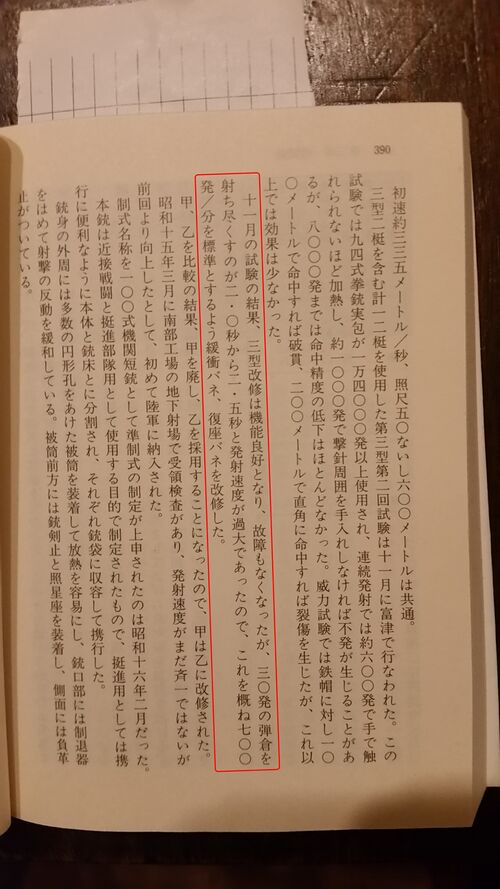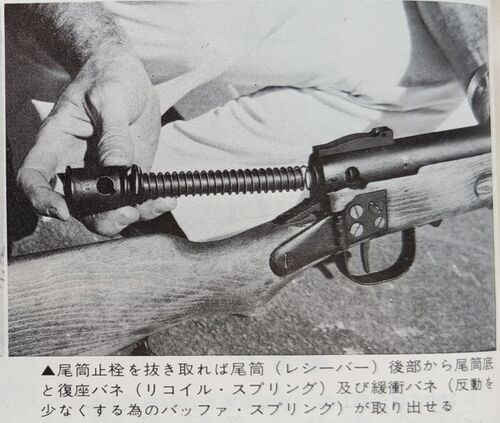| If you have been locked out of your account you can request a password reset here. |
Difference between revisions of "Talk:Type 100 Submachine Gun"
(Type 100/40 ROF) |
|||
| Line 1: | Line 1: | ||
| + | =discussion= | ||
How come these Type 100s are never seen in any WWII movies that deals with the Pacific theater so far? Was the Type 100 SMGs were so few in number that they didn't have any impact for the Imperial Army arsenal? Is there no Type 100s that survived from WWII is that the reason? | How come these Type 100s are never seen in any WWII movies that deals with the Pacific theater so far? Was the Type 100 SMGs were so few in number that they didn't have any impact for the Imperial Army arsenal? Is there no Type 100s that survived from WWII is that the reason? | ||
| Line 10: | Line 11: | ||
Wouldn't a 9mm Type 100 be a wannabe Sten?--[[User:FIVETWOSEVEN|FIVETWOSEVEN]] 15:01, 14 July 2010 (UTC) | Wouldn't a 9mm Type 100 be a wannabe Sten?--[[User:FIVETWOSEVEN|FIVETWOSEVEN]] 15:01, 14 July 2010 (UTC) | ||
:Or a Lanchester or a MP28? Except it wouldn't look like it was assembled by a sophomore in shop class? --[[User:Funkychinaman|funkychinaman]] 15:09, 14 July 2010 (UTC) | :Or a Lanchester or a MP28? Except it wouldn't look like it was assembled by a sophomore in shop class? --[[User:Funkychinaman|funkychinaman]] 15:09, 14 July 2010 (UTC) | ||
| + | |||
| + | ==Type 100/40 & Type 100/40 Para. correct rate of fire== | ||
| + | |||
| + | This has been a long standing mistake in all sorts of games and web pages. | ||
| + | But before I show some sources lets have a “brief” introduction into the terminology I will be using. | ||
| + | |||
| + | <br> | ||
| + | '''Introduction''' | ||
| + | <br> | ||
| + | |||
| + | Model 3 = Name for a few SMGs that would develop into the initial Type 100 SMG. Visually they’re very similar to the Type 100 and there are about 4 variations but lets not get into that here. | ||
| + | <br> | ||
| + | *Q: Why Model 3 instead of Type? | ||
| + | *A: Because Type 3 would imply 1943 adoption after the Japanese calendar (Imperial Year 2603) according to the naming system adopted in 1929, experimental weapons didn’t use shiki. | ||
| + | **試製三型機関短銃 → Experimental Model 3 Short Machine gun | ||
| + | **一〇〇式機関短銃 → Type 100 Short Machine gun | ||
| + | (yes I know the number is written first in Japanese “100 Type”) | ||
| + | <br> | ||
| + | *式 - shiki - type | ||
| + | *型 - kata/gata - model | ||
| + | *号 - gou/gō - mark | ||
| + | <br> | ||
| + | Type 100/40 = The early pattern of the Type 100 SMG, easily identified by the bayonet mounting bar below the barrel and range adjustable rear sight. Adopted 1941. | ||
| + | <br> | ||
| + | Type 100/40 Para = Early Type 100 converted to paratrooper configuration with a folding stock hinge. (Called Type 100 Special in IJN documents, I know) | ||
| + | |||
| + | <br> | ||
| + | '''Correct Rate of Fire''' | ||
| + | <br> | ||
| + | |||
| + | Now lets get to the main point, the correct rate of fire. 700rpm. Not 450. For both Type 100/40 and Type 100/40 Para. | ||
| + | |||
| + | *To prove this I have 3 separate sources to share, | ||
| + | |||
| + | **A page from a 1943 manual (only image available) | ||
| + | [[File:Type 100-40 ROF 1.jpeg|thumb|none|500px]] | ||
| + | “Rate of fire about 700 rounds per minute” | ||
| + | |||
| + | **An article on the Type 100 from the Japanese “Gun” Magazine, 1976 January. Page 26: | ||
| + | [[File:Type 100-40 ROF 2.jpeg|thumb|none|500px]] | ||
| + | “発射速度は毎分700発の性能を有している。” | ||
| + | “It has a rate of fire of 700 rounds per minute.” | ||
| + | This source is particularly important as the author Keiichi Kunimoto (国本圭一) fired the Type 100/40 Para on a US range. | ||
| + | [[File:Type 100-40 ROF 3.jpeg|thumb|none|500px]] | ||
| + | He’s an experienced shooter who can certainly tell the difference between 450 and 700rpm. | ||
| + | |||
| + | **“Introduction to Rifles, Handguns, and Machine Guns: A Thorough Study of Japanese Small Arms”(小銃・拳銃・機関銃入門―日本の小火器徹底研究) by Sayama Jiro(佐山二郞) a Japanese military historian who wrote several books. Page 390 of this book: | ||
| + | [[File:Type 100-40 ROF 4.jpeg|thumb|none|500px]] | ||
| + | |||
| + | Sayama writes: | ||
| + | “十一月の試験の結果、三型改修は機能良好となり、故障もなくなったが、三〇発の弾倉を射ち尽くすのが二・〇秒から二・五秒と発射速度が過大であったので、これを概ね七〇〇発/分を標準とするよう緩衝バネ、復座バネを改修した。” | ||
| + | “As a result of the test in November, the Model 3 improved function was good and there were no malfunctions, but the rate of fire was excessive, as it took 2.0 seconds to 2.5 seconds to exhaust the 30-round magazine. The buffer spring and the return spring were modified to standardize this to approximately 700 rounds per minute.” | ||
| + | (note: November 1939) | ||
| + | No changes regarding the rate of fire are noted after this so the Model 3 700rpm carried over to the Type 100/40 on adoption. | ||
| + | |||
| + | <br> | ||
| + | The modified buffer and return spring can be seen in a picture from the 1976 “Gun” magazine article on page 28: | ||
| + | [[File:Type 100-40 ROF 5.jpeg|thumb|none|500px]] | ||
| + | |||
| + | *Origin of the 450 number | ||
| + | |||
| + | **Q: So where does the 450rpm number come from? Basically every English source seems to state it. | ||
| + | **A: There are some theories among Japanese researchers, one of them is the diagonal line in the number 7 that some people write, which could make it look like a 4. | ||
| + | I’ve seen some books report the RoF 400-450rpm so this could indeed be possible. | ||
| + | Especially considering Model 3A and Model 3B had a rate of fire of 755rpm, 755->455->450? | ||
| + | |||
| + | I assume no one corrected this mistake in English sources so far because well… the Type 100/40 is rare, I’ve yet to ever see one fired on video. So everyone just copies the number written on wikipedia or from older English books. Maybe one day someone will be able to track down who was the first to make this mistake. | ||
| + | |||
| + | *Sources | ||
| + | |||
| + | ***Type 100 manual from the Weapons Course (Showa 18)(1943). image taken from this post: https://twitter.com/matsumotomorio/status/1520738676866658304 1 thanks to Mister Morio for making me aware of this issue in the first place, I knew this for a while thanks to him but haven’t had the time to put it in a post until now. | ||
| + | |||
| + | ***“Gun” Magazine, 1976 January edition, images provided by a friend of mine. | ||
| + | |||
| + | ***“Introduction to Rifles, Handguns, and Machine Guns: A Thorough Study of Japanese Small Arms”(小銃・拳銃・機関銃入門―日本の小火器徹底研究) by Sayama Jiro(佐山二郞) image taken by myself. | ||
| + | |||
| + | **Additional sources: | ||
| + | |||
| + | ***The Japanese → English translation basis for Type, Model, Mark is taken from this article on Japanese Gas masks The Evolution of the Japanese Army Gas Mask (1918-1945) as well as the book “Japanese Military Cartridge Handguns 1893-1945” by Harry L. Derby and James D. Brown | ||
| + | ***the 7->4 theory is from this message: https://twitter.com/waltherP383/status/1521128356800253952 3 , there is some more speculation about the origin of the mistake in this thread as well. | ||
| + | |||
| + | The article was provided by me from https://forum.enlisted.net/t/type-100-early-correct-rate-of-fire/113083. The author of the post on the Enlisted forum is '''"Killerwolf1024"'''. The post contains a lot of detailed information about the weapon itself, so I decided to present it here. If it violates copyright, the entry will be deleted. I wrote to the author of the post about the possibility of sharing it here. I am waiting for a response. --[[User:Mateogala|Emto]] ([[User talk:Mateogala|talk]]) 08:02, 6 August 2023 (UTC) | ||
Revision as of 08:03, 6 August 2023
discussion
How come these Type 100s are never seen in any WWII movies that deals with the Pacific theater so far? Was the Type 100 SMGs were so few in number that they didn't have any impact for the Imperial Army arsenal? Is there no Type 100s that survived from WWII is that the reason?
- I think you just answered your own question Excalibur01 05:20, 6 May 2010 (UTC)
- I saw a documentary on Japanese WWII small arms and it said fewer than 10,000 were ever produced. Most of those only saw scattered use toward the end of the war though a fairly large number saw action on Okinawa. -Anonymous
The Type 100 does look cool, you have to admit. If you could rechamber one to 9mm, it'd actually be pretty useful. Hughjefender
- As I understand it the 8x22 Nambu cartridge was also severely underpowered for use in an automatic weapon as well as the fact that the materials available for production were also of extremely poor quality later in the war. Chroming of the barrel, for example, became next to impossible as Japan fell into retreat. --Charon68 09:52, 14 July 2010 (UTC)
Wouldn't a 9mm Type 100 be a wannabe Sten?--FIVETWOSEVEN 15:01, 14 July 2010 (UTC)
- Or a Lanchester or a MP28? Except it wouldn't look like it was assembled by a sophomore in shop class? --funkychinaman 15:09, 14 July 2010 (UTC)
Type 100/40 & Type 100/40 Para. correct rate of fire
This has been a long standing mistake in all sorts of games and web pages. But before I show some sources lets have a “brief” introduction into the terminology I will be using.
Introduction
Model 3 = Name for a few SMGs that would develop into the initial Type 100 SMG. Visually they’re very similar to the Type 100 and there are about 4 variations but lets not get into that here.
- Q: Why Model 3 instead of Type?
- A: Because Type 3 would imply 1943 adoption after the Japanese calendar (Imperial Year 2603) according to the naming system adopted in 1929, experimental weapons didn’t use shiki.
- 試製三型機関短銃 → Experimental Model 3 Short Machine gun
- 一〇〇式機関短銃 → Type 100 Short Machine gun
(yes I know the number is written first in Japanese “100 Type”)
- 式 - shiki - type
- 型 - kata/gata - model
- 号 - gou/gō - mark
Type 100/40 = The early pattern of the Type 100 SMG, easily identified by the bayonet mounting bar below the barrel and range adjustable rear sight. Adopted 1941.
Type 100/40 Para = Early Type 100 converted to paratrooper configuration with a folding stock hinge. (Called Type 100 Special in IJN documents, I know)
Correct Rate of Fire
Now lets get to the main point, the correct rate of fire. 700rpm. Not 450. For both Type 100/40 and Type 100/40 Para.
- To prove this I have 3 separate sources to share,
- A page from a 1943 manual (only image available)
“Rate of fire about 700 rounds per minute”
- An article on the Type 100 from the Japanese “Gun” Magazine, 1976 January. Page 26:
“発射速度は毎分700発の性能を有している。” “It has a rate of fire of 700 rounds per minute.” This source is particularly important as the author Keiichi Kunimoto (国本圭一) fired the Type 100/40 Para on a US range.
He’s an experienced shooter who can certainly tell the difference between 450 and 700rpm.
- “Introduction to Rifles, Handguns, and Machine Guns: A Thorough Study of Japanese Small Arms”(小銃・拳銃・機関銃入門―日本の小火器徹底研究) by Sayama Jiro(佐山二郞) a Japanese military historian who wrote several books. Page 390 of this book:
Sayama writes: “十一月の試験の結果、三型改修は機能良好となり、故障もなくなったが、三〇発の弾倉を射ち尽くすのが二・〇秒から二・五秒と発射速度が過大であったので、これを概ね七〇〇発/分を標準とするよう緩衝バネ、復座バネを改修した。” “As a result of the test in November, the Model 3 improved function was good and there were no malfunctions, but the rate of fire was excessive, as it took 2.0 seconds to 2.5 seconds to exhaust the 30-round magazine. The buffer spring and the return spring were modified to standardize this to approximately 700 rounds per minute.” (note: November 1939) No changes regarding the rate of fire are noted after this so the Model 3 700rpm carried over to the Type 100/40 on adoption.
The modified buffer and return spring can be seen in a picture from the 1976 “Gun” magazine article on page 28:
- Origin of the 450 number
- Q: So where does the 450rpm number come from? Basically every English source seems to state it.
- A: There are some theories among Japanese researchers, one of them is the diagonal line in the number 7 that some people write, which could make it look like a 4.
I’ve seen some books report the RoF 400-450rpm so this could indeed be possible. Especially considering Model 3A and Model 3B had a rate of fire of 755rpm, 755->455->450?
I assume no one corrected this mistake in English sources so far because well… the Type 100/40 is rare, I’ve yet to ever see one fired on video. So everyone just copies the number written on wikipedia or from older English books. Maybe one day someone will be able to track down who was the first to make this mistake.
- Sources
- Type 100 manual from the Weapons Course (Showa 18)(1943). image taken from this post: https://twitter.com/matsumotomorio/status/1520738676866658304 1 thanks to Mister Morio for making me aware of this issue in the first place, I knew this for a while thanks to him but haven’t had the time to put it in a post until now.
- “Gun” Magazine, 1976 January edition, images provided by a friend of mine.
- “Introduction to Rifles, Handguns, and Machine Guns: A Thorough Study of Japanese Small Arms”(小銃・拳銃・機関銃入門―日本の小火器徹底研究) by Sayama Jiro(佐山二郞) image taken by myself.
- Additional sources:
- The Japanese → English translation basis for Type, Model, Mark is taken from this article on Japanese Gas masks The Evolution of the Japanese Army Gas Mask (1918-1945) as well as the book “Japanese Military Cartridge Handguns 1893-1945” by Harry L. Derby and James D. Brown
- the 7->4 theory is from this message: https://twitter.com/waltherP383/status/1521128356800253952 3 , there is some more speculation about the origin of the mistake in this thread as well.
The article was provided by me from https://forum.enlisted.net/t/type-100-early-correct-rate-of-fire/113083. The author of the post on the Enlisted forum is "Killerwolf1024". The post contains a lot of detailed information about the weapon itself, so I decided to present it here. If it violates copyright, the entry will be deleted. I wrote to the author of the post about the possibility of sharing it here. I am waiting for a response. --Emto (talk) 08:02, 6 August 2023 (UTC)
